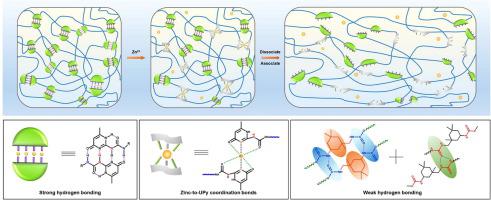Chemical Engineering Journal ( IF 13.3 ) Pub Date : 2022-08-18 , DOI: 10.1016/j.cej.2022.138673 Jing Xu , Xiaoyue Wang , Xinrui Zhang , Yaoming Zhang , Zenghui Yang , Song Li , Liming Tao , Qihua Wang , Tingmei Wang

|
Developing a new generation of polymeric materials that integrate robust mechanical properties with ultra-high self-healing efficiency at ambient temperature remains a formidable challenge due to the proverbial trade-offs among strength, toughness, and self-healing ability. Herein, inspired by biological systems (titin protein molecular structure and Nereis jaws), a series of updated supramolecular polyurethanes have been successfully synthesized by incorporating hierarchical hydrogen-bonding motifs into the polymer matrix and subsequently coordinated with Zn2+ ions. Relying on collaborative reinforcement of optimized hierarchical hydrogen bonds and metal-ligand coordination bonds, the resulted supramolecular elastomers exhibited a robust strength of ∼14.15 MPa, an excellent toughness of ∼47.57 MJ m−3, and Young’s modulus of ∼146.92 MPa. Benefiting from the rational design of hard domains, high mobility of chains, and the synergistic effect of multiple non-covalent interactions, the mechanical properties are far superior to the previously reported room‐temperature self‐healing materials. In addition, with the structural design of “inner soft and external hard” model, we also fabricated a bilayer polymer film with a gradient distribution that can achieve rapid self-healing, with an unexpectedly high self-healing efficiency of 95% at ambient temperature in 24 h. This work opens up a new avenue for fabricating room-temperature self-healing materials with robust mechanical strength and toughness at the same time.
中文翻译:

基于仿生分级氢键相互作用和配位键协同强化的室温自修复超分子聚氨酯
由于众所周知的强度、韧性和自修复能力之间的权衡,开发新一代聚合材料,将强大的机械性能与环境温度下的超高自修复效率相结合,仍然是一项艰巨的挑战。在此,受生物系统(titin 蛋白分子结构和 Nereis 颚)的启发,通过将分级氢键基序结合到聚合物基质中并随后与 Zn 2+离子配位,成功合成了一系列更新的超分子聚氨酯。依靠优化的分级氢键和金属配体配位键的协同增强,所得超分子弹性体表现出~14.15 MPa的稳健强度,~47.57 MJ·m的优异韧性-3,杨氏模量约为 146.92 MPa。得益于硬畴的合理设计、链的高迁移率以及多种非共价相互作用的协同效应,其机械性能远远优于先前报道的室温自愈材料。此外,通过“内软外硬”模型的结构设计,我们还制备了具有梯度分布的双层聚合物薄膜,可实现快速自愈,在常温下自愈效率高达95%。在 24 小时内。这项工作为制造同时具有强大机械强度和韧性的室温自愈材料开辟了一条新途径。















































 京公网安备 11010802027423号
京公网安备 11010802027423号